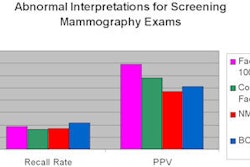Being able to identify critically ill patients at the onset of acute lung injury (ALI) can help save their lives. Intubated patients who develop acute lung injury or acute respiratory distress syndrome have a 40% to 50% chance of dying from these lung conditions.
Software developed at the University of Pennsylvania in Philadelphia may help physicians reduce this mortality rate. The application performs real-time analysis of radiology reports of chest x-rays and arterial blood gas laboratory reports, and can identify cases of acute lung injury as rapidly and almost as accurately as physicians, facilitating faster treatment.
A multidisciplinary team of specialists in respiratory care, radiology, infectious diseases, medical informatics, and IT services developed the software. The second of three validation studies the team has conducted since 2002 is described in the Journal of the American Medical Informatics Association (July/August 2009, Vol. 16:4, pp. 503-508).
Acute lung injury is identified by the acute onset of bilateral pulmonary infiltrates on a chest x-ray that are consistent with pulmonary edema. Other symptoms include a ratio of the partial pressure of arterial oxygen to the fraction of inspired oxygen (PaO2/FiO2) of 300 or less and a pulmonary artery occlusion pressure of 18 mm Hg or less.
Patients in intensive care units (ICUs) who have acute lung injury generally require mechanical ventilation. However, mechanical ventilators can exacerbate the condition. By limiting alveolar pressures and utilizing small tidal volumes as a lung-protective ventilation strategy, mortality can be reduced significantly in these patients.
However, lung-protective ventilation strategies are underutilized in hospital ICUs, even though clinical trials have proved their validity, according to lead author Dr. Helen Azzam, M.P.H., a physician in the division of infectious diseases at the University of Pennsylvania School of Medicine. Azzam and colleagues suggest that this is due to underrecognition of acute lung injury. Contributing to the lack of recognition are the subjective nature of the radiographic and hemodynamic criteria, the fact that the PaO2/FiO2 ratio may not be routinely calculated at frequent enough intervals in the ICU, and the fact that a large number of diseases display similar symptoms as acute lung injury.
Automated real-time screening software can change this. It has the potential to increase diagnostic efficiency, objectivity, and surveillance for acute lung injury to achieve both clinical and quality improvements. If the tool were utilized to monitor the estimated 200,000 annual cases of acute lung injury in the U.S. along with implementing lung-protective ventilation, mortality could be reduced by 8.8% to 33%, according to the researchers.
How it works
The screening tool is designed to identify all patients supported by mechanical ventilators by analyzing patient records in the hospital information system. It analyzes laboratory results of arterial blood gas samples, which are available within less than a minute of being processed. And it analyzes the content of radiology reports, a preliminary interpretation being available approximately one hour after the chest x-ray has been taken, and a final report typically being posted in the RIS within two hours after the exam.
The software is designed to search for key words in the radiology report text to identify the presence of bilateral infiltrates, and for words and phrases consistent with acute lung injury. Examples of the latter include "infiltrates," "aspiration," "pulmonary edema," "acute respiratory distress syndrome (ARDS)," "opacities," "pneumonia," and "congestive heart failure."
The screening tool depends upon the consistent use of words and phrases that it has been programmed to identify as potentially representing acute lung injury by the radiologists. It was important to have radiologists involved in selecting the vocabulary and their buy-in to use the words and terms in their reports that they identified as "red flag" vocabulary, according to Dr. Barry Fuchs, director of the medical ICU and medical director of respiratory care services at the University of Pennsylvania.
The validation study
In fact, the diagnostic accuracy and sensitivity of the software is dependent upon consistent use of red flag terminology by radiologists.
This fact was confirmed by the results of a prospective validation study conducted between October 2005 and April 2007 at the Hospital of the University of Pennsylvania. The laboratory and radiology records of 199 severely injured trauma patients who had injury severity scores greater than 16 were reviewed by two experienced physicians and also the automated screening tool.
Two experienced physicians reviewed the chest x-ray images to identify images unequivocally showing bilateral infiltrates consistent with pulmonary edema, with or without the assistance of radiology reports. They also manually calculated the PaO2/FiO2 ratios using all available laboratory data. They made a diagnosis of acute lung injury when both lab and radiology criteria generated within a 24-hour period identified criteria for the condition.
The automated screening tool made a similar evaluation, but was limited to laboratory data and the exclusive use of radiology reports.
The research team compared the day on which acute lung injury was first identified by each group. A total of 53 patients, or 26.6%, were identified by the two physician reviewers as meeting criteria for the condition.
The screening tool identified 46 of the 53 cases. It identified seven cases earlier than the physicians and six cases later than they did. It proved to have a diagnostic accuracy of 88%, a sensitivity of 87%, and a specificity of 89%.
The research team determined that variations in the language of the radiology reports was responsible for the screening tool missing four of the seven cases it failed to correctly identify. The radiology reports of the 16 false positives included terms to indicate the presence of bilateral infiltrates, one of the red flag trigger words. The research team did not explain how a difference in x-ray interpretation between the radiologists and the ICU attending physician reviewers was resolved. Given the severity of the potential consequences of acute lung injury, the research team felt it was beneficial to have the automatic screening tool agree with the radiologists.
Continuing use and research
The screening tool has continued to be used for intubated patients in the hospital ICU. "We feel that performance is excellent. The system has been sending e-mail alerts to a limited number of physicians, and we believe that it is helping us to identify ALI earlier," Fuchs told AuntMinnie.com.
"We are in the process of testing the automated system in its ability to change physician practice with respect to improving the implementation of lung-protective ventilation. As a part of this study, we will look at the effectiveness of the alert on different clinicians in the ICU team, to determine which practitioner would be best to receive and react to the alert. We anticipate that this will include groups like respiratory therapists, interns, residents, fellows, and attending physicians," he said.
"We want to scientifically document if a potentially lifesaving tool like this will change physician behavior, and if so, by how much. We need to establish whether physicians will accept the recommendations of electronic technology and implement lung-protective ventilation," Fuchs explained.
If the next research study determines that the screening tool does make a positive impact on patient care, Fuchs and colleagues see the potential of automated acute lung injury screening tool alerts being implemented in hospitals throughout the world.
By Cynthia E. Keen
AuntMinnie.com staff writer
August 21, 2009
Related Reading
Echocardiography predicts pulmonary artery pressure in ventilated patients, March 25, 2008
Copyright © 2009 AuntMinnie.com



















